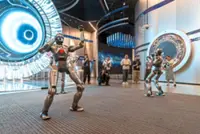Roomba robot vacuums made by iRobot are displayed on a shelf at a Target store on Aug 5, 2022 in San Rafael, California. The Roomba taught the humans who brought it to life that robots had to be affordable, they had to be technologically possible and they had to be capable of tasks people like Joe Jones would rather avoid. — AFP
The first robot that many human beings welcomed into their homes was a peculiar creature born 20 years ago with a funny name.
It didn’t look the way we imagined robots, and it didn’t perform the tasks we envisioned outsourcing to robots. We pictured self-driving cars. We got a self-driving vacuum cleaner.
Already a subscriber? Log in
Save 30% OFF The Star Digital Access
Cancel anytime. Ad-free. Unlimited access with perks.





